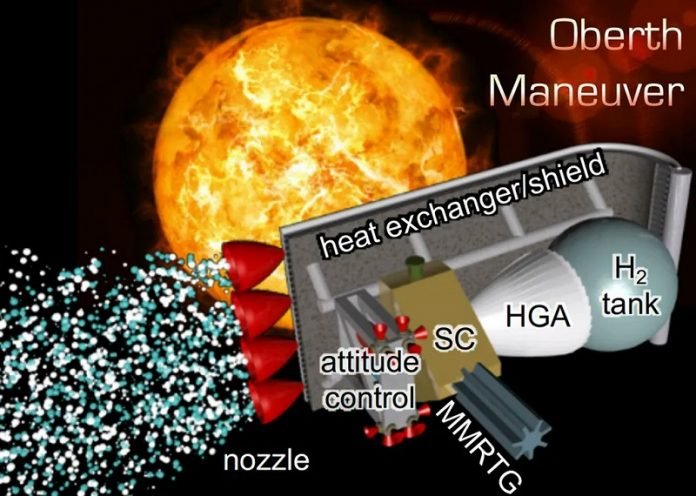
We’ve reported before on the conceptual mission known as the Interstellar Probe.
This ambitious mission would visit the interstellar medium about 1,000 AU away from the Sun.
But how exactly would the probe get there in a reasonable time frame?
It has taken Voyager 35 years to travel less than 10% of that distance.
The answer might lie in an old technology that has been given new life by advances in material science – the solar thermal propulsion system.
NASA is now helping develop this system by financing a proof of concept study as part of its NASA Innovative Advanced Concepts program.
Dr. Jason Benkoski, a material scientist and one of the Interstellar Probe team members at John Hopkins University’s Applied Physics Laboratory, will receive $175,000 to study his concept of an updated solar shield and solar thermal propulsion system.
The underlying concept behind the Interstellar Probe is simple – get a spacecraft to move orders of magnitude faster than any other manufactured object ever has.
But that is much easier said than done.
Voyager itself used a gravity slingshot and several orbits utilizing a technique called an “Oberth maneuver.” Interstellar Probe would employ a similar maneuver, only around a much bigger target – the Sun.
During an Oberth maneuver, a spacecraft in orbit around an object would fire its propulsion system during the period of its orbit where it’s at its highest speed, known as the periapsis.
This occurs when the spacecraft is at the closest approach to the object, and the closer the approach, the faster the orbital boost.
Usually, if Jupiter or another planet is the focal point of the orbit, this close approach is not too dangerous. But if the focal point is the Sun, the calculations change dramatically.
The closer a spacecraft can get to the Sun, the more it stands to benefit from an Oberth maneuver.
However, most materials that could be used as a heat shield would melt under the radiation emitted at distances that could slingshot the Interstellar Probe into interstellar space. Until now anyway.
Dr. Benkoski has developed a novel solution to this problem. His team developed a type of heat shield with small channels embedded in it. These channels would then be filled with hydrogen and plumbed to an exhaust nozzle.
When the heat shield does its duty and attempts to dissipate the heat, it absorbs from the Sun, the hydrogen inside the channels heats up and is forced out of the exhaust nozzle.
That exhaust is a vital feature of a propulsion system, and as such, this heat shield can also double as one, known as a solar thermal propulsion system.
Initially developed in the 1960s, these systems were thought infeasible due to the thermal limitations of materials available back then. But, material science has advanced significantly in the last 60 years, and Dr. Benkoski and his team thought they could do better.
So they did. They took a modified cargo shipping container, fitted with banks of LEDs that shine with 20 times the intensity of the Sun on Earth.
It was originally designed to simulate the solar environment that Parker Solar Probe is currently being subjected to.
But it would also be helpful to test any future Interstellar probe attempting to perform an Oberth maneuver near the Sun. Dr. Benkoski and his team developed a 20 cm x 20 cm sheet of heat shield test material with hydrogen channels hooked up to an exhaust nozzle. Previously this sort of test setup had only been modeled theoretically, with many doubting that a physical manifestation would work.
But it did work. The high-temperature hydrogen was pushed out the exhaust nozzle just as expected, and there was a measurable thrust when it did so.
It is an excellent proof of concept, but any mission needs to scale itself up significantly and tackle other technical problems while it does so.
One of those problems is relatively simple to quantify and is the focus of the Phase I NIAC study: which propellant would give the best result in this novel solar thermal propulsion system.
The NIAC proposal calls out six potential propellants ranging from lithium to water.
Also included were analytical models of physical properties such as the specific impulse and the full system mass it can have and still get up to a speed of 10 AU / year.
That speed dwarfs Voyager (3.6 AU/year) and even a Space Launch System rocket using a similar Oberth maneuver on Jupiter (8 AU/year).
Speeds like that would enable a variety of potential exploration targets, including some of the 130 known dwarf planets in the outer solar system or the interstellar medium that reaches out to the 1,000 AU original goal set by the Interstellar Probe team.
No matter the goal, the advancement of this technology is welcome to anyone interested in high-speed movement throughout the solar system.
The Phase I NIAC program lasts nine months, at which point Dr. Benkoski and his team can apply for a 2-year Phase II grant to further flesh out the concept.
Whether they receive Phase II or not, now that the idea has been released to the public, this is undoubtedly not the last we’ll hear of solar thermal propulsion systems.
Written by Andy Tomaswick.
Source: Universe Today.



